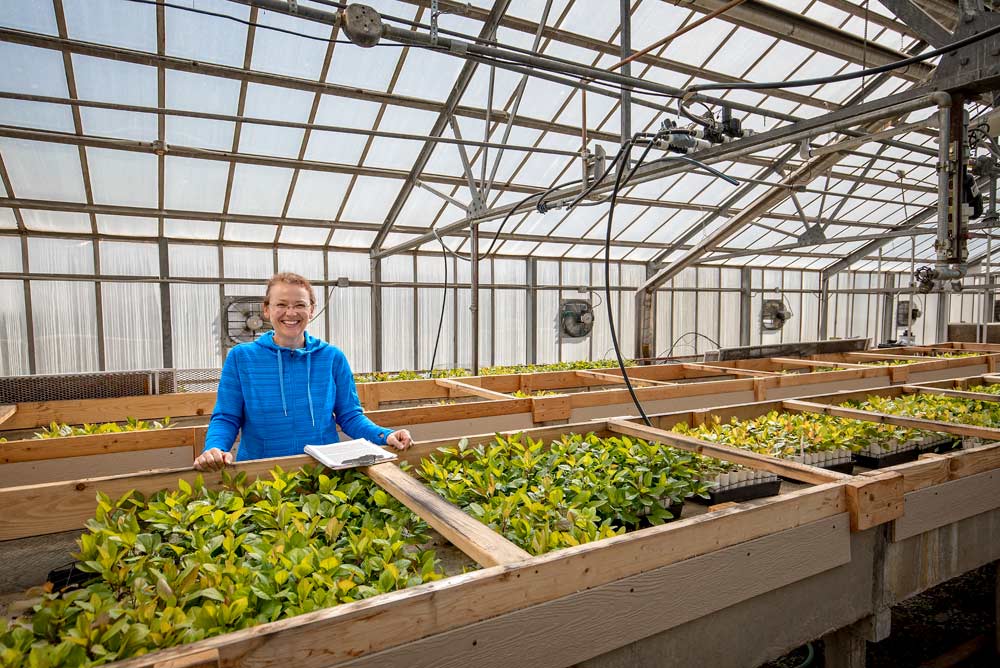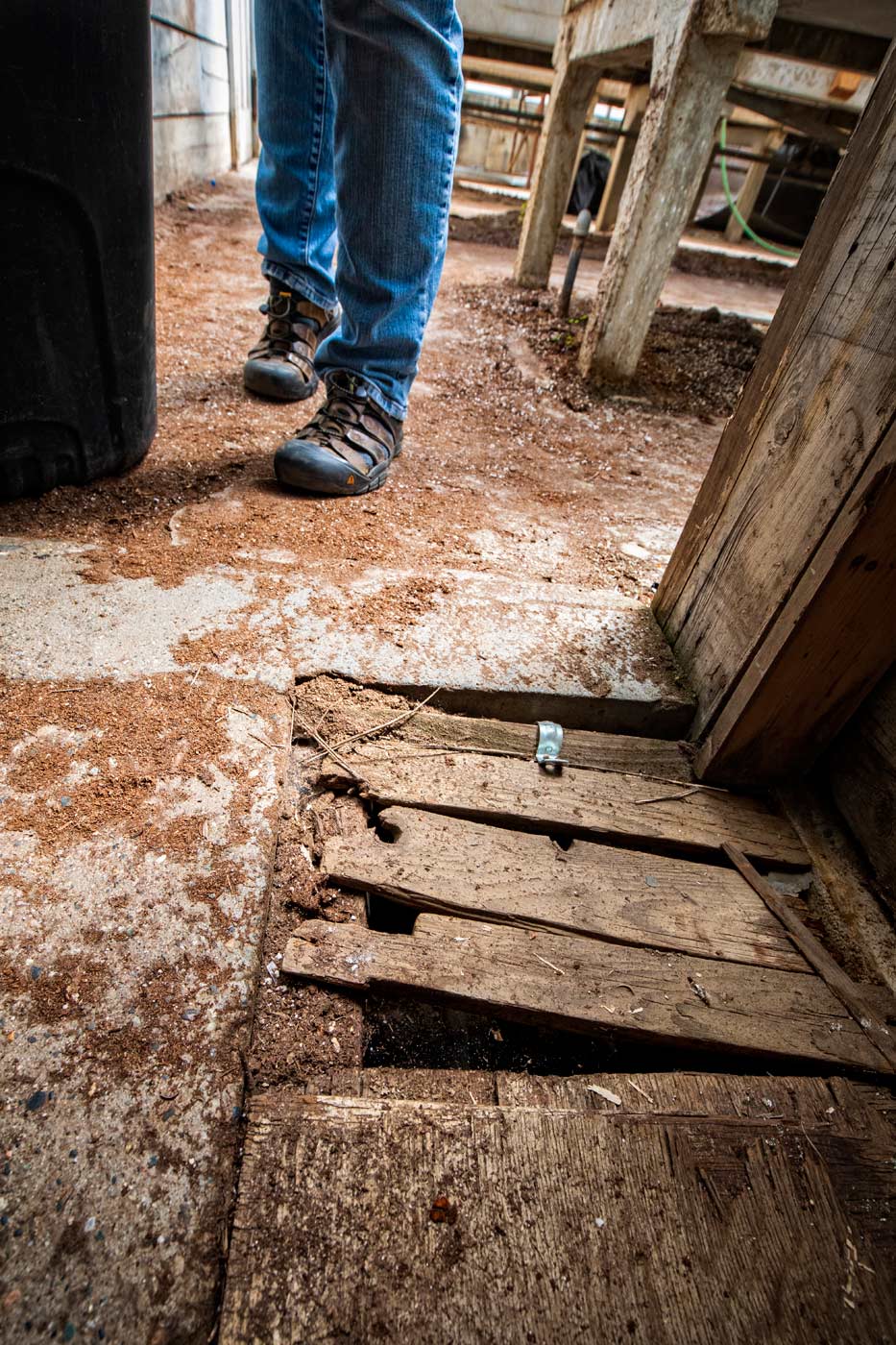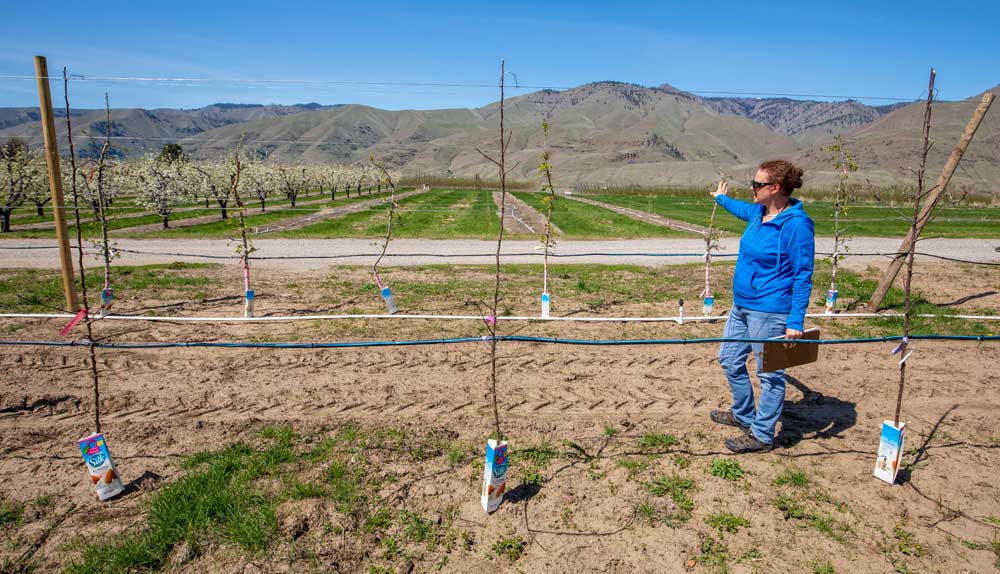
Kate Evans, Washington State University’s pome fruit breeder, is surrounded by her “phase 0” seedlings growing in the WSU Tree Fruit Research & Extension Center in Wenatchee, Washington, greenhouses on Monday, April 23, 2018. Evans says even though the breeding program has been around for 24 years, it’s very young compared to other programs around the globe. With Cosmic Crisp a few years away from consumers, she admits there’s mounting pressure to build off its success. However, Evans says the small team makes do using repurposed, antiquated facilities and inadequate staff workspaces that hamper the program’s potential. For instance, this greenhouse and headhouse, once a USDA facility built over 60 years ago, has forced the staff to content with an ever growing list of non-research associated issues, from parts failures, rat invasions and potentially hazardous facility flaws. (TJ Mullinax/Good Fruit Grower)
The well-hyped Cosmic Crisp is in the ground and on its way. So, what’s next?
The Washington State University apple breeding program, which released the variety, now stands at a crossroads. Breeder Kate Evans has more potential new varieties in the pipeline. Her greenhouse needs renovations. She wants help in her research orchard.
Meanwhile, though WA 38, to be marketed as Cosmic Crisp, is still a few years from store shelves, the university faces decisions about how to allocate royalties projected to reach millions.
The 24-year-old breeding program is young compared to its competitors around the world. Those of Cornell University and the University of Minnesota date back to the late 1800s. However, the apple industry expects Evans and her team to build off Cosmic’s success.
“Like any breeding program, I’m a firm believer that it should evolve,” Evans told growers in January at the Washington Tree Fruit Research Commission apple research review in Pasco. “The breeding program at WSU, any breeding program, evolves.”
She and the industry have some suggestions.

For WSU breeding program staff, following in Cosmic Crisp’s success comes with potential pitfalls every day. Staff must navigate through narrow, rotting doorways, step over and around broken and cut concrete floors covered with makeshift steel plating and at worst scrap wood, just to successfully grow future apple varieties. (TJ Mullinax/Good Fruit Grower)
Facilities
Evans seeks more labor to help maintain the Columbia View research orchard north of Wenatchee and more accurate DNA tests to help her genetically screen for a wider array of traits. But facilities’ improvement needs, also near the top of her wish list, may be the most obvious.
Evans and her staff at the Tree Fruit Research and Extension Center in Wenatchee share a greenhouse and storage with other programs.
The 60-year-old structure with missing floorboards and a stone for a door prop lets in mice and rats attracted to her tender seedlings.
A laminated handwritten sign implores visitors to keep out beans, grains and seeds. Her staff built rat-proof cages out of mesh screens that bolt onto raised wooden frames directly over the plants. So far, that seems to be working, Evans said.
Meanwhile, equipment failures, rust and overcrowding also get in the way of her team’s work, she said.
Upgrades are needed elsewhere at the Wenatchee research center, which has not seen additions since the 1970s. Laboratory space is at a premium. “I got a list of 51 items,” quipped one audience member at the research review.
Growers and researchers are lobbying for a master facilities plan for the research centers in Wenatchee and Prosser, both of which have programs involving tree fruit. The university is working toward one, but it won’t happen all at once, said Scot Hulbert, associate dean of research for WSU College of Agricultural, Human and Natural Resource Sciences, or CAHNRS.
Turnover and adding new hires at WSU take time. In May, Hulbert replaced Jim Moyer, who retired, while the agriculture college’s new dean, André-Denis Girard Wright, was scheduled to start June 1.
The university is in the process of hiring a postharvest physiologist and soil specialist for horticultural programs. Those faculty members will have needs for facilities and equipment just to start their jobs. “That’s got to happen now or very soon,” he said.
Like many universities, WSU has a backlog of deferred maintenance. The university has been assessing those needs across the entire campus since last year, said Kimi Lucas, CAHNRS director of operations.
This summer, the two fruit research centers will begin the creation of a long-term plan when an outside design team holds workshops with faculty and staff. Then comes finding a way to pay for the work, through a combination of university funds, grants, endowments, etc., she said.
Part of a recent $32 million endowment from the tree fruit industry, the largest in WSU history, is slated for facilities and research orchard improvements. However, the endowment won’t shoulder the whole burden, Lucas said.
“It would definitely not be only the endowment,” she said.

Dilapidated makeshift greenhouse benches, screws for holding down protective rat caging, irrigation parts storage… just one example of how the WSU Tree Fruit Research & Extension Center facility staff is making do with antiquated facilities and equipment. (TJ Mullinax/Good Fruit Grower)
Changes in past 10 years
The breeding program was created in 1994. Evans arrived in 2008, after Cosmic Crisp and yet-to-be released selections L and M were first crossed.
Since then, the apple industry has seen numerous changes. Managed varieties, usually in the form of clubs, are on the rise. Honeycrisp has set new expectations among consumers. Technology for DNA marker detection has improved.
Behind it all, Cosmic Crisp has created a new model for releasing apples that skirts the club method but also manages the variety.
Washington growers get exclusive North American rights to propagate and sell Cosmic for the first 10 years while the university contracted with Yakima, Washington-based Proprietary Variety Management, or PVM, to launch the apple commercially.
However, that doesn’t mean other varieties will follow the same path, Moyer said. The university has a cultivar licensing committee to help determine the rollout for each product.
He does not believe the university is required by law to put commercialization of a variety out to public bid, though that’s how PVM was hired for WA 38. “It depends on what the ask is,” Moyer said. If it’s just a matter of issuing a license, probably not, he said; if more services are required, then it might.
PVM also has been contracted to manage WA 2, the apple breeding program’s first apple released in 2009 and trade named Sunrise Magic.
PVM has made no overtures on any further releases, said Moyer and Lynnell Brandt, company president.

Evans points out cultivars in various stages of development at the Columbia View research orchard near Wenatchee. The row of trees to her right are kept as “mother” trees for new crosses, while the buds to her left are younger trees starting Phase 1. “Every year we plant trees, but every year we take out trees, as well,” she said. (TJ Mullinax/Good Fruit Grower)
Royalties
Though Cosmic Crisp is still a couple of years away from store shelves, stakeholders are already discussing how to spend the money it will make.
PVM projects 9 million 40-pound boxes on store shelves in 2022. Even if they sell for only $20 per box — an extremely low estimate — that would generate $180 million in sales. Washington State University charges 4.25 percent in royalties, meaning $7.65 million for one year. That doesn’t include royalties growers pay for each tree they purchase.
As spelled out in the faculty manual, half of those royalties will go to the breeders, the university’s Office of Commercialization and the university’s Agricultural Research Center. The second half must be set aside for the “enhancement of vegetatively propagated variety programs in consultation with the breeders.” Fruit trees are propagated vegetatively or by grafting; grains such as wheat and barely are propagated by seed.
The university is forming a committee of packers, growers and other industry stakeholders to devise a blueprint for how that second portion of the royalties are distributed. University officials hope to convene the group this summer, Hulbert and Moyer said. One idea is to create an endowment, designed to fund the program’s work regardless of what happens to prices and the market. “You never know how long this wave is going to last.”
That’s how the University of Minnesota handles royalties from its varieties, Honeycrisp, for which its patent has run out, SweeTango, Frostbite and others. Rave will join the list soon.
The endowment of the Minnesota breeding program now stands at $1.6 million, said Jim Luby, director of fruit breeding programs, which is designed to help sustain the program in lean years. “You just don’t get hits that often,” Luby said. “It’s wonderful to have something like a Honeycrisp or a Cosmic Crisp, but those won’t come around every five years.”
The Minnesota program has released 27 new varieties to the world in its time. The state was once known for Haralson, a popular regional cultivar released in 1922 and the most widely grown apple in Minnesota until Honeycrisp was released in 1991.
Cornell, with 66 apple varieties under its belt, does not set aside royalties into an endowment, said breeder Susan Brown, creator of SnapDragon and RubyFrost, though she thinks that’s a good idea for WSU’s Cosmic Crisp royalties.
Other than royalties, Minnesota’s breeding efforts are funded only through general taxes. At Cornell and WSU, the industry contributes directly through grower research assessments. The Washington Tree Fruit Research Commission recently approved another year of WSU apple scion development, led by Evans, to the tune of $268,000. Evans also receives grants from other organizations.
Besides the grants, the Research Commission partners directly with the breeding program to manage grower evaluations and directly carries out some supporting research. All told, over the past 10 years, the commission has funded $3.1 million worth of activities related to the breeding program.
The growers would like to change their funding role in the future, said Mike Willett, manager of the Research Commission. They don’t plan to withdraw their support, but they think royalties should fund the basic program, from crossing through fruit evaluation, while the commission’s grants go to new ideas and experiments.
“The use of royalty funds to support the core activities of the breeding program would free grower resources to allow greater emphasis on funding novel and emerging research directions in the apple breeding program,” he said.
Some growers on the commission contacted by Good Fruit Grower deferred comments to Willett.
Moyer and Evans are glad to hear growers are willing to continue funding at some level. They believe that industry investment will keep growers and packers “at the table,” as Evans described it, involved in the decision making and creativity.
“One of the strengths of this program is that it’s so interactive with the industry,” Evans said. •
—by Ross Courtney
This story has been updated to correct three details: 1.) the number of new varieties released by the University of Minnesota program; 2.) the spelling of the variety Frostbite; and 3.) that royalties are also used to fund Minnesota’s breeding efforts.
A 360 degree view of the WA 38 mother tree at the Washington State University Columbia View research orchard near Wenatchee, Washington. From this tree all commercial first generation Cosmic Crisp apples began. (TJ Mullinax/Good Fruit Grower)






Leave A Comment